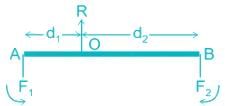Test: Equilibrium of Rigid Bodies - JEE MCQ
10 Questions MCQ Test - Test: Equilibrium of Rigid Bodies
The Mechanical advantage of a lever is given by-


The figure shows a dish kept at an orientation with a marble placed on it. If the marble in figure is displaced slightly, it would rattle about for a while and come to rest in its original place. This is an example of :


The rock has a mass of 1 kg. What is the mass of the measuring stick if it is balanced by a support force at the one-quarter mark? The centre of mass of the measuring stick is at the one-half mark, one-quarter of the stick’s length beyond the pivot.

A pair of equal and opposite forces with different line of action are said to form a
A meter rule is supported at its centre. It is balanced by two weights, A and B. If A and B are placed at a distance 20 cm, and 40 cm from the centre of scale, find the weight of B. The weight of A is 50N.
Determine the force that must be applied to end of the class 1 lever shown below to lift the 500 lb load.
Five forces are separately applied to a flat object lying on a table of negligible friction as shown in figure. The force which will not cause the object to rotate about the centre of the object is

Which of the following appliance works on the principle of moments.
There are two blocks of mass 3 kg and 5 kg hanging from the ends of a rod of negligible mass. The rod is marked in eight equal parts as shown. At which of the points indicated should a string be attached if a rod is to remain horizontal when suspended from the string?





















